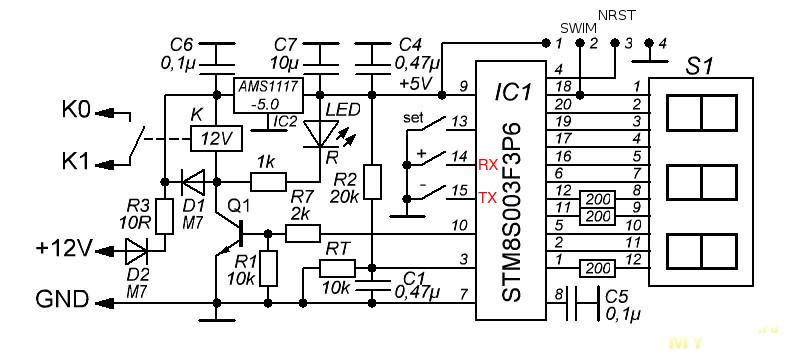(STM8S003F3P6 pinout)
-
UART_Hardware: UART1 TX pin 2; RX pin 3 (115200 bauds) 547 bytes (original code)
-
- Application address 0x8280 (Free 7645 bytes)
-
UART_Software: UART1 TX pin 15; RX pin 14 (9600 bauds) 935 bytes (by timers)
-
- Application address 0x83C0 (Free 7257 bytes)
-
No bootloader: application address 0x8000 (Free 8192 bytes)
-
See also Makefile for changing application address
-
- (LDFLAGS += --code-loc 0x83C0)
Serial bootloader for STM8S and STM8L microcontrollers. A detailed write-up on this bootloader is posted here.
(Backup PDF in the Doc folder)
- small - fits in 547 bytes (SDCC v3.6.8 #9951)
- fast - uploads 4k binary in 1 second @115200bps
- configurable - can be adjusted for parts with different flash block size
The default configuration targets low-density devices (STM8S003). To compile for a different target MCU and FAMILY makefile variables are adjusted accordingly.
Bootloader configuration is located in config.h.
- BLOCK_SIZE - flash block size according to device datasheet. This should be set to 64 for low-density devices or 128 for devices with >8k flash.
- BOOT_ADDR - application boot address.
- BOOT_PIN - entry jumper. This is set to PD3 by default.
- RELOCATE_IVT - when set to 1 (default) the interrupt vectors are relocated. When set to 0 the bootloader will overwrite it's own interrupt vector table with the application's IVT, thus eliminating additional CPU overhead during interrupts. Write-protection cannot be used in this case and resulting binary is slightly larger.
Boot address must be a multiple of BLOCK_SIZE. Address is set in 2 places:
- config.h
- init.s
Main application is compiled with --code-loc <address> option. When RELOCATE_IVT is set to 0, 0x80 must be subtracted from application address and isr29 must be implemented: void dummy_isr() __interrupt(29) __naked { ; }.
Build and flash the bootloader:
$ make && make flashEnable write-protection (UBC) on pages 0-9 (TODO: must be adjusted for STML):
$ make opt-set- Bootloader: UART_Hardware
There is a demo application inside app directory (0x8280) which toggles PD4 via interrupts. To upload the application short PD3 to ground, power-cycle the MCU and run the uploader utility. DTR pin on UART-USB converter (TTL level only: 5V) can be connected to RESET pin on STM8 for automatic reset.
(boot.py: 115200 bauds)
$ cd app && make
$ python ../uploader/boot.py -p /dev/ttyUSB0 firmware.bin- Bootloader: USART_Software
There is a demo application inside app directory (0x83C0) which toggles PA3 (Relay) via interrupts. To upload the application short PC3 to ground (press SET button), power-cycle the MCU and run the uploader utility. DTR pin on UART-USB converter (TTL level only: 5V) can be connected to RESET pin on STM8 for automatic reset (RESET connection is close to the display: NRST).
(boot-9600.py: 9600 bauds)
$ cd app && make
$ python ../uploader/boot.py -p /dev/ttyUSB0 firmware.bin- W1209 board schematic:
- The bootloader starts at address 0x8000, and if it does not enter update mode, it jumps to the application address.
- The bootloader must be made to jump to the correct application start address.
- The bootloader can also be made to launch more than one application, one at a time.
- The stm8flash allows you to direct the start of firmware programming, by default it is 0x8000, but you can use the directive -s 0x8000 for example.
- To test the bootloader whether the bootloader is jumping to the application address, you can program the bootloader and application using ST-link:
To program the bootloader:
stm8flash -c stlinkv2 -p stm8s003?3 -s 0x8000 -w bootloader_file.bin
To program the app (base adress 0x8280):
stm8flash -c stlinkv2 -p stm8s003?3 -s 0x8280 -w app_file.bin
To program the app (base adress 0x83C0):
stm8flash -c stlinkv2 -p stm8s003?3 -s 0x83C0 -w app_file.bin
Note: This library is distributed in the hope that it will be useful, but WITHOUT ANY WARRANTY; without even the implied warranty of MERCHANTABILITY or FITNESS FOR A PARTICULAR PURPOSE
